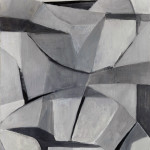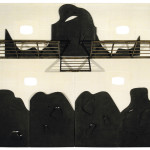Biography
Born in Brooklyn, Mr. Scarpitta grew up in Los Angeles, where his father, an Italian-born sculptor, created the exterior bas-reliefs on the Los Angeles Stock Exchange building and his Russian-born mother briefly acted. After graduating from Hollywood High School, he studied at the Academy of Fine Arts in Rome. During World War II he joined the United States Navy, where he was a “monuments man,” part of a multinational group charged with searching out, cataloging and rescuing art from the Nazis, as well as identifying monuments and historical sites to protect from Allied bombings.
After the war Mr. Scarpitta continued making art in Rome until 1958, when the dealer Leo Castelli lured him to New York with the promise of an exhibition and financial assistance.
The following January Mr. Castelli unveiled a series of Mr. Scarpitta’s wrapped, or “bandaged,” canvases in a show titled “Extramurals.” At once macho and tender, the mostly monochromatic works were bound in webbing and canvas he had found at Army surplus stores, often with an opening in them not unlike that of a birthing gown — a symbol, Mr. Scarpitta said, of man’s potential for spiritual renewal.
The automobile culture of his California childhood fueled his lifelong fascination with movement, or lack thereof. In the mid-1960s he created a series of racing cars, among them the “Rajo Jack Special,” a reproduction of the car driven by one of the country’s first African-American racecar drivers, and “Lynx,” a full-size, fully operational World War II armored car.
But Mr. Scarpitta wasn’t content merely to fashion speedsters. He raced them as part of a team at a dirt track near his second home in New Oxford, Pa., the name of his crew sponsor — the Leo Castelli Gallery — emblazoned on the side of his own car, No. 59.
In the 1970s Mr. Scarpitta began constructing sleds, which resembled nothing so much as slow-motion archaeological artifacts, from discarded objects — chairs, hockey sticks, Christmas trees — he scavenged from trash bins around the city.
“I wrapped my sleds,” he said in an interview with James Harithas, founding director of the Station Museum of Contemporary Art in Houston. “It was just natural. They had their own kind of skin.” He added, “It was like wanting to give it a breathing capability of its own that could come out of the matter it was made of.”
The painter Willem de Kooning bought Mr. Scarpitta’s first sled.

 Untitled
Untitled
 Balcony
Balcony